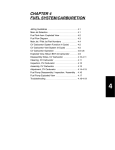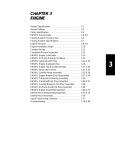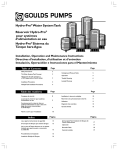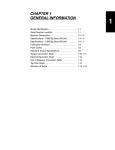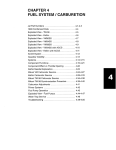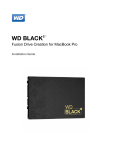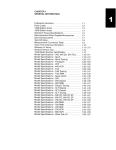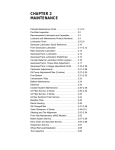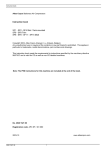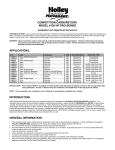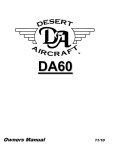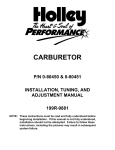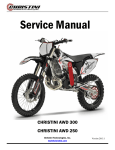Download 9915083 1999-2000 Vol. III ATV Service Manual Chapter
Transcript
CHAPTER 4 FUEL SYSTEM/CARBURETION Jetting Guidelines . . . . . . . . . . . . . . . . . . . . . . . . . . . . Main Jet Selection . . . . . . . . . . . . . . . . . . . . . . . . . . . . Fuel and Oil Tank Asm. Exploded View, 2 Cycle . . Fuel Tank Asm. Exploded View, 4 Cycle . . . . . . . . . Fuel Flow Diagrams . . . . . . . . . . . . . . . . . . . . . . . . . . . Main Jet / Pilot Jet Part Numbers . . . . . . . . . . . . . . . 2 Cycle Section Carburetor Component Function (2 Cycle) . . . . . . . Carburetor Circuit Operation (2 Cycle) . . . . . . . . . . . Carburetor Vent Systems (2 Cycle) . . . . . . . . . . . . . Float Height Adjustment (2 Cycle) . . . . . . . . . . . . . . Needle and Seat Leakage Test (2 Cycle) . . . . . . . . Exploded View, Mikuni VM 30 / 34 SS Carburetor 4 Cycle Section CV Carburetor System Function (4 Cycle) . . . . . . . CV Carburetor Vent System (4 Cycle) . . . . . . . . . . . CV Carburetor Operation . . . . . . . . . . . . . . . . . . . . . . Exploded View, Mikuni BST 34 Carburetor . . . . . . . Exploded View, Mikuni BST 40 Carburetor . . . . . . . Disassembly Notes, CV Carburetor . . . . . . . . . . . . . Cleaning, CV Carburetor . . . . . . . . . . . . . . . . . . . . . . Inspection, CV Carburetor . . . . . . . . . . . . . . . . . . . . . Assembly, CV Carburetor . . . . . . . . . . . . . . . . . . . . . . Adjustment, CV Carburetor . . . . . . . . . . . . . . . . . . . . Fuel Pump Fuel Pump Disassembly / Inspection / Assembly . Fuel Pump Exploded View . . . . . . . . . . . . . . . . . . . . . Troubleshooting . . . . . . . . . . . . . . . . . . . . . . . . . . . . . . 4.1 4.1 4.2 4.3 4.4 4.5 4.6 - 4.9 4.10 - 4.15 4.16 4.16 4.16 4.17 4.18 4.18 4.19 - 4.21 4.22 4.23 4.24 - 4.25 4.26 4.27 4.28 4.29 - 4.30 4.31 4.32 4.33 - 4.34 FUEL SYSTEM/CARBURETION Jetting Guidelines Jetting Guidelines Changes in altitude and temperature affect air density, which is essentially the amount of oxygen available for combustion. In low elevations and cold temperatures, the air has more oxygen. In higher elevations and higher temperatures, the air is less dense. Carburetors on Polaris ATV and 6x6 vehicles are calibrated for an altitude of 0-3000 ft. (0-900 meters) and ambient temperatures between +40 and +80° F (+5° to +26° C). Carburetors must be re-calibrated if operated outside the production temperature and/or altitude range. The main jet installed in production is not correct for all altitudes and/or temperatures. In addition, air screw / pilot screw adjustments may be required to suit operating conditions. CAUTION: A main jet that is too small will cause a lean operating condition and may cause serious engine damage. Select the correct main jet carefully for elevation and temperature according to the charts in the General/ Specifications Chapter, or in the Owner’s Safety and Maintenance Manual for each particular model. Air Screw (2 Cycle) / Pilot Screw (4 Cycle) Adjustment NOTE: Maximum engine efficiency and horsepower are directly related to proper carburetor and clutch settings. The jetting charts should be used as a guideline for selecting optimum jetting for varying temperature and altitude conditions. Air screw or fuel screw adjustment will affect mixture from approximately idle to 1/4 throttle setting. Refer to Maintenance Chapter 2 for complete adjustment procedure, and the following guidelines for minor altitude adjustments. Air Screw (2 stroke models) Turn the air screw in (clockwise) 1/4 turn for each 30° below 60° F. Turn the air screw out (counterclockwise) 1/4 turn for each 30° above 60° F. Fuel Screw (4 stroke models) Turn the fuel screw in (clockwise) 1/4 turn for each 30° above 60° F. Turn the fuel screw out (counterclockwise) 1/4 turn for each 30° below 60° F. Main Jet Selection IMPORTANT: The following guidelines must be followed when establishing a main jet setting: 1. 2. 3. 4. Select the lowest anticipated temperature at which the machine will be operated. Determine the lowest approximate altitude at which the machine will be operated. Select the correct main jet from the chart. Clutching changes may also be required for changes in elevation. Refer to clutching charts in General / Specifications Chapter 1 for recommendations. MODEL: . . . . . . . . . . 500 6X6 MODEL NUMBER: . A99AE50AA ENGINE MODEL: . . EH50PLE06 EXAMPLE ONLY (Refer to Chapter 1) Production Main Jet outlined in BOLD JETTING CHART CARBURETION Type . . . . . . . . . . . . . . . . Main Jet . . . . . . . . . . . . Pilot Jet . . . . . . . . . . . . . Jet Needle . . . . . . . . . . . Needle Jet . . . . . . . . . . . Throttle Valve . . . . . . . . Pilot Screw . . . . . . . . . . Pilot Air Jet . . . . . . . . . . Valve Seat . . . . . . . . . . . Fuel Octane (R+M/2) . Polaris Sales Inc. AMBIENT TEMPERATURE BST 34 Mikuni 140 40 4D33-3 Q-6 #100 2 160 1.5 87 Non-Oxygenated or 89 Oxygenated Below 0°F Below -18°C 18 C 0_ to +40_F -18 to +5_C +5 C -18_to +40_to +80_F +5 C +5_ to +26 +26_C Above +80_F +80 F Above +26_C 0-900 (0-3000) 150 145 140 135 900-1800 (3000-6000) 145 140 135 130 1800-2700 (6000-9000) 137 5 137.5 135 130 122 5 122.5 2700-3700 (9000-12000) 132 5 132.5 127 5 127.5 122 5 122.5 117 5 117.5 Altitude Meters (Feet) - Pilot screw in 1/2 turn 4.1 4/99 FUEL SYSTEM/CARBURETION Fuel Tank Assembly / Oil Tank Assembly Typical 2 Cycle model with tankmounted fuel valve. Details vary by model. Refer to parts manual. Forward Fuel tank-mounted valve Oil Level Sensor Vent Hose Oil Tank Oil Filter Forward Polaris Sales Inc. 4. 4/99 FUEL SYSTEM/CARBURETION Fuel Tank Assembly Vent line routed smoothly into center of steering post Typical 2 Cycle or 4 Cycle model with frame-mounted fuel valve. Details vary by model. Forward Outlet “2 (Res)” “1 (ON)” Silver fitting (short stand pipe) to “Reserve” (marked 2) on fuel valve Gold fitting (tall stand pipe) to “ON” (marked 1) on fuel valve Tank to fuel valve connection -Gold fitting (tall stand pipe) to “ON” (marked 1) on fuel valve “1 (ON)” Reserve Silver fitting (short stand pipe) to “Res” (marked 2) on fuel valve 4/99 “2 (Reserve)” 4.3 Polaris Sales Inc. FUEL SYSTEM/CARBURETION Fuel Flow Diagrams Fuel System Diagram - 2 Stroke Models Fuel Tank Vent Fuel Tank Fitting Screens Fuel Filter Fuel Valve Carburetor Vent Carburetor Engine Fuel System Diagram - 4 Stroke Models Fuel Tank Vent Fuel Tank Fitting Screens L Fuel Pump Filter Fuel Valve Carburetor Vent Carburetor Engine L 325 / 425 Under Headlamp Cover 335 / 500 Above Oil Tank Polaris Sales Inc. 4. 4/99 FUEL SYSTEM/CARBURETION Mikuni Jet Part Numbers Pilot Jets Part Numbers Mikuni VM (2 Cycle) Jet No. Part No. 30 3130331 35 3130066 40 3130067 45 3130068 50 3130069 Main Jet Part Numbers (4 Cycle) Mikuni BST Carburetor Jet Number 112.5 115 117.5 120 122.5 125 127.5 130 132.5 135 137.5 140 142.5 145 147.5 150 152.5 155 157.5 160 162.5 165 167.5 170 Hex Main Jet Part Numbers Mikuni VM (2 Cycle) Jet No. 110 115 120 125 130 135 140 145 150 155 160 165 170 175 180 185 190 195 200 210 220 230 240 250 260 270 280 290 300 310 320 4/99 Part No. 3130105 3130106 3130107 3130108 3130109 3130110 3130111 3130112 3130113 3130114 3130115 3130116 3130117 3130118 3130119 3130120 3130121 3130122 3130123 3130124 3130125 3130126 3130127 3130128 3130129 3130130 3130131 3130132 3130133 3130134 3130135 Part Number 3130554 3130555 3130556 3130557 3130558 3130559 3130560 3130561 3130562 3130563 3130564 3130527 3130566 3130567 3130568 3130569 3130570 3130571 3130572 3131141 3131142 3131143 3131144 3131145 Pilot Jet Part Numbers (4 Cycle) Mikuni BST Carburetor Jet Number 40.0 42.5 4.5 Part Number 3130624 3130526 Polaris Sales Inc. FUEL SYSTEM/CARBURETION Fuel Tank Assembly / Oil Tank Assembly Typical 2 Cycle model with tankmounted fuel valve. Details vary by model. Refer to parts manual. Forward Fuel tank-mounted valve Oil Level Sensor Vent Hose Oil Tank Oil Filter Forward Polaris Sales Inc. 4.6 4/99 FUEL SYSTEM/CARBURETION Component Functions (2 Cycle) Pilot Jet From idling to low speeds, the fuel supply is metered by the pilot jet. There are several air bleed openings in the sides of the pilot jet which reduce the fuel to mist. The number stamped on the jet is an indication of the amount of fuel in cc’s which passes through the jet during a one minute interval under a given set of conditions. Pilot Jet Indicator Number Pilot Air Screw The pilot air screw controls the fuel mixture from idle to low speeds. The tapered tip of the air screw projects into the air passage leading to the pilot jet air bleeds. By turning the screw in or out, the cross sectional area of the air passage is varied, in turn varying the pilot jet air supply and changing the mixture ratio. Pilot Air Screw Air/Fuel Mixture Ratio A carburetor with a piston type throttle valve is also called a variable venturi type carburetor. In this type of carburetor, the needle jet and jet needle serve to control a proper air/ fuel mixture ratio at the medium throttle valve opening (between 1/4 and 3/4 opening). Having the proper needle jet and jet needle has a major impact on engine performance at partial load. E-Clip Position Vs. Fuel Flow 2 3 4 4 The jet needle tapers off at one end and the clearance between the jet needle and the needle jet increases as the throttle valve opening gets wider. The air/fuel mixture ratio is controlled by the height of the “E” ring inserted into one of the five slots provided in the head of the jet needle. The chart at right shows the variation of fuel flow based on the height of the “E” ring. 3 2 15 50 75 100% Throttle Valve Opening 4/99 4.7 Polaris Sales Inc. FUEL SYSTEM/CARBURETION Component Functions (2 Cycle) Jet Needle The jet needle has five adjustment grooves cut into the upper portion, and is tapered from approximately the middle of the needle to the lower end. The top is fixed to the center of the throttle valve by the needle clip, and the tapered end extends into the needle jet. Fuel flows through the space between the needle jet and jet needle. This space does not vary until the throttle reaches the 1/4 open point. At that time the tapered portion of the needle begins to move out of the jet, affecting fuel flow as the opening enlarges. If the needle clip is changed from the standard position to a lower groove, the needle taper starts coming out of the jet sooner, resulting in a richer mixture. Moving the clip higher produces a leaner mixture. If the taper is worn due to vibration, fuel flow may be significantly affected. Jet Needle Leaner Groove Richer Needle Jet The needle jet works in conjunction with the jet needle to regulate fuel flow rate. An air bleed opening in the side of the needle jet brings in air measured by the air jet. This air initiates the mixing and atomizing process inside the needle jet. Mixing is augmented by a projection at the needle jet outlet, called the primary choke. The letter number code stamped on the jet indicates jet inside diameter. Opening faces engine Needle Jet Washer Main Jet Throttle Opening vs. Fuel Flow In a full throttle condition the cross sectioned area between the jet needle and the needle jet is larger than the cross sectioned area of the main jet. The main jet therefore has greater control over fuel flow. Small Clearance Closed Throttle Polaris Sales Inc. 4.8 One-half Throttle Medium Clearance Large Clearance Full Throttle 4/99 FUEL SYSTEM/CARBURETION Component Functions (2 Cycle) Throttle Valve Throttle Valve The throttle valve controls the rate of engine air intake by moving up and down inside the main bore. At small throttle openings, air flow control is performed chiefly by the cutaway. By controlling air flow the negative pressure over the needle valve is regulated, in turn varying the fuel flow. Engine Side Air Box Side The throttle valves are numbered 1.0, 1.5, 2.0, etc., according to the size of the cutaway. The higher the number, the leaner the gasoline/air mixture. Cutaway Higher cutaway number = leaner mixture Main Jet When the throttle opening becomes greater and the area between the needle jet and jet needle increases, fuel flow is metered by the main jet. The number on the jet indicates the amount of fuel CCs which will pass through it in one minute under controlled conditions. Larger numbers give a greater flow, resulting in a richer mixture. Main Jet Mikuni Hex Style Main Jet Main jets are screwed directly into the needle jet base. Larger Number = Richer Mixture 4/99 4.9 Polaris Sales Inc. FUEL SYSTEM/CARBURETION Starter System - Closed Throttle (2 Cycle) Mikuni carburetors use a starter system rather than a choke. In this type of carburetor, fuel and air for starting the engine are metered with entirely independent jets. The fuel metered in the starter jet is mixed with air and is broken into tiny particles in the emulsion tube. The mixture then flows into the plunger area, mixes again with air coming from the air intake port for starting and is delivered to the engine through the fuel discharge nozzle in the optimum air/fuel ratio. The starter is opened and closed by means of the starter plunger. The starter type carburetor is constructed to utilize the negative pressure of the inlet pipe, so it is important that the throttle valve is closed when starting the engine. Cable Adjuster Cable Adjuster Lock Nut Plunger Spring Plunger Cap Throttle Valve Starter Plunger Inlet Starter Air Starter Emulsion Tube Inlet Bleed Air Starter Jet Polaris Sales Inc. 4.10 4/99 FUEL SYSTEM/CARBURETION Pilot System (0-3/8 Throttle) (2 Cycle) The pilot system’s main function is to meter fuel at idle and low speed driving. Though its main function is to supply fuel at low speed, it does feed fuel continuously throughout the entire operating range. Fuel for the pilot jet is drawn from the float bowl, mixed with air regulated by the air screw, and delivered to the engine through the pilot outlet. The mixture is regulated to some degree by adjusting the air screw. When the air screw is closed, the fuel mixture is made richer as the amount of air is reduced. When the air screw is opened, the mixture is made more lean as the amount of air is increased. Throttle Valve Throttle Stop (Idle Speed) Screw Bypass Pilot Outlet Air Screw Pilot Jet 4/99 4.11 Polaris Sales Inc. FUEL SYSTEM/CARBURETION Slide Cutaway (1/8-3/8 Throttle) (2 Cycle) Throttle valve cutaway effect is most noticeable at 1/4 throttle opening. The amount of cutaway is pre-determined for a given engine to maintain a 14:1 air/fuel ratio at part throttle. A steep angle would indicate a fairly lean mixture because there is less resistance to air flow. A flat angle would provide a much richer mixture because there is more resistance to air flow. The venturi shape can be adjusted for each engine’s breathing characteristics by using a different valve cutaway angle. A number will be stamped into the bottom of the valve (e.g. 2.5) indicating the size of the cutaway. The higher the number, the steeper the angle. Cutaway Angle Throttle Valve Jet Needle Air Jet By-pass Pilot Outlet Engine Side Air Box Side Pilot Jet Needle Jet Main Jet 3.0 1.5 Larger Leaner Polaris Sales Inc. Smaller Richer 4.12 4/99 FUEL SYSTEM/CARBURETION Jet Needle/Needle Jet (3/8-3/4 Throttle) (2 Cycle) The jet needle and needle jet have the most effect between 3/8 and 3/4 throttle opening. Some mixture adjustment can be accomplished by changing the location of the “E” clip on the needle. Moving the clip down raises the needle in the jet passage and richens the mixture. Moving the clip up lowers the needle in the jet passage and leans the mixture. Letter and number codes are stamped into the needle and the jet indicating sizes and tapers of each. Clip Position (Shown in #3) Throttle Valve Jet Needle Air Jet By-pass Pilot Outlet Pilot Jet Needle Jet Main Jet 1 Leaner 3 Richer 5 2 4 Jet Needle “E” Clip Position 4/99 4.13 Polaris Sales Inc. FUEL SYSTEM/CARBURETION Main System (3/4 to Full Throttle) (2 Cycle) The main system is designed for delivering fuel between low speed and high speed operation. This system is made up of the jet needle, needle jet, and main jet. The main system begins to take effect as soon as there is enough air flow into the carburetor venturi to draw fuel up through the main jet and needle jet assembly. This system works in conjunction with the needle jet system. During low speed driving, there is very little clearance between the jet needle and the needle jet; therefore, very little fuel from the main jet can pass between the jet needle and the needle jet. As the throttle valve opening is increased, the tapered jet needle is raised farther out of the needle jet, allowing greater fuel flow. Under full throttle opening, the cross sectioned area of clearance between the jet needle and the needle jet becomes greater than the cross sectioned area of the main jet. Thus the main jet is now controlling the amount of fuel flow. Throttle Valve Jet Needle Air Jet By-pass Pilot Outlet Pilot Jet Needle Jet Main Jet Polaris Sales Inc. 4.14 4/99 FUEL SYSTEM/CARBURETION Component Effect vs. Throttle Opening (2 Cycle) Mikuni Fuel Delivery (2 Cycle) The throttle opening chart below demonstrates component relationship to fuel flow versus throttle valve opening. The pilot system’s main function is that of a low speed jet. Its most effective range of fuel delivery is from idle to approximately 3/8 throttle valve opening. The throttle valve controls the rate of engine air by its movement up and down in the carburetor venturi. At small throttle openings the air flow is regulated chiefly by the valve cutaway, with greatest effectiveness at 1/4 throttle opening. Throttle valves are numbered 1.0, 1.5, 2.0, etc., according to the size of the cutaway. Decreasing the cutaway number will increase the amount of fuel delivered in its effective range. The jet needle and needle jet have an effective operating range from approximately 1/8 to 7/8 throttle opening. The amount of fuel delivered during this range relies upon the jet needle clip position, as well as the needle jet size and other specifications. INCREASING The main jet affects fuel delivery at 1/4 throttle and consistently increases to full throttle opening. DECREASING EFFECT THROTTLE OPENING - 2 Cycle Throttle Valve Cut-Away Jet Needle/Needle Jet Carburetor Component Function - 2 Cycle System Main Components Main Function Float System (Fuel Level Control) Inlet Pipe, Needle and Seat, Floats, Float Pins Maintains specified fuel level in float chamber (carburetor float bowl) All systems All throttle ranges Venting Vent Passages in Carburetor, Vent line Supplies atmospheric pressure to fuel in float chamber All systems All throttle ranges Starter (Choke/Enrichment) Choke Lever, Cable, Choke Plunger, Return Spring, Carb Passages (Starter Jet, passage in float bowl) Supplies additional fuel air mixture necessary for cold starting All throttle ranges Greatest effect at low throttle settings and idle speeds Pilot (Idle System) Pilot Jet/Passageways, Pilot Air Screw with Spring, Bypass Port (Beneath Throttle Slide), Air Jet, Pilot Outlet, Throttle Valve Cutaway Primarily supplies fuel at idle Mainly idle to 1/4 throttle and low throttle settings Minimal effect after 1/2 throttle Main System Main Jet, Main Air Passage, Needle Jet, Jet Needle, Throttle Valve Supplies fuel at mid-range and high throttle settings. 4/99 4.15 Main Affect 1/4 to full throttle Polaris Sales Inc. FUEL SYSTEM/CARBURETION Vent Systems (2 Cycle) Vent Systems - 2 Cycle The fuel tank and carburetor float bowl vent lines supply atmospheric pressure to the fuel in the tank and float bowl. The lines must be free of kinks and restrictions to prevent lean mixture and possible engine damage. Vent lines must be properly routed to prevent damage to the line and to prevent contaminants from entering the carburetor or fuel tank. A one-way check valve is in place on the bowl overflow hose, to allow overflow fuel out, and prevent water or other contaminants from entering the bowl. (See photo below right). To Frame To Frame To “T” Fitting and Check Valve Check Valve Carburetor Venting (30MM) Carburetor Venting (34MM) Float Height - 2 Cycle Float Arm 1. Invert the carburetor and remove float bowl. 2. Rest the float tongue lightly on the inlet needle valve pin without compressing the spring. Gasket Surface Parallel 3. Measure height from float bowl mating surface to float arm as shown. Both sides of float arm must be parallel to each other. Use float adjustment tool (PN 2872314) or a vernier caliper. When measuring height, be sure inlet needle valve spring is not compressed. If adjustment is necessary, bend the tongue slightly. Float Height: VM 30 Parallel to Gasket Surface ± 1mm VM 34 Parallel to Gasket Surface ± Needle1mm and Seat Leakage Test - 2 Cycle 1. Install the float bowl. Invert the carburetor and install a Mity-Vac™ (PN 2870975) to the fuel inlet fitting. Apply 5 PSI pressure to inlet fitting. The needle and seat should hold pressure indefinitely. If not, inspect needle and seat and seat O-ring or gasket. Polaris Sales Inc. 4.16 4/99 FUEL SYSTEM/CARBURETION 2 Cycle Mikuni VM30SS / VM34SS Carburetor Exploded View 1. Cap 2. Spring 1 Refer to Page 4.8 for Jet Part Numbers 2 Jet Needle “E” Clip Position 1 4 5 30 9. Starter Plunger 10. Spring, Air Adj. Screw 4 7 5 8 9 6 28 19. Drain Plug 20. Float Bowl 11 12 27 13 14 25. Arm, Float 26. Pin, Float 22 27. Gasket, Inlet Valve 28. Carb Body Assy. (1-30) 21 29. Needle Jet 30. E-Clip 20 17 18 21. Float 22. Cap 23. Gasket 24. Valve, Inlet Needle 15 23 25 13. Screw, Throttle Stop 14. Pilot Jet 17. Main Jet 18. O-Ring 10 24 11. Screw, Air Adjust 12. Spring, Throttle Stop Screw 15. Washer, Main Jet 16. Screw and Washer Assy. 29 26 5. Washer 6. Valve, Throttle 7. Cap, Plunger 8. Spring 3 2 3 3. Plate, Cable Retainer 4. Jet Needle 16 19 Check Valves To Carburetor Flow Use a spring loaded center punch to remove press-fit float pin. 4/99 4.17 No Flow Polaris Sales Inc. FUEL SYSTEM/CARBURETION Mikuni CV Carburetor System Components (4-Cycle) 4 Cycle CV Carburetor System Function Carburetor Component Function - 4 Cycle System Main Components Main Function Main Affect Float System (Fuel Level Control) Inlet Pipe, Needle and Seat, Float, Float Pin Maintains specified fuel level in float chamber (carburetor float bowl) All systems All throttle ranges Venting Vent Passages in Carburetor, Vent lines (2) into (1) to frame Supplies atmospheric pressure to fuel in float chamber All systems All throttle ranges Starter (Choke/Enrichment) Choke Lever, Cable, Choke Supplies additional fuel air Plunger, Return Spring, Carb mixture necessary for cold Passages (Starter Jet, Starter starting Bleed Pipe) All throttle ranges Greatest effect at low throttle settings and idle Pilot (Idle System) Pilot Jet/Passageways, PilotMixture Screw with Spring Washer and Sealing O-Ring, Bypass Ports (Behind Throttle Plate), Pilot Air Jet, Pilot Outlet, Throttle Plate Primarily supplies fuel at idle and low throttle settings Mainly idle to 1/4 throttle Minimal effect after 1/2 throttle Main System Main Jet, Main Air Jet, Main Air Passage, Needle Jet, Jet Needle, Vacuum Slide, Throttle Plate Supplies fuel at mid-range and high throttle settings. 1/4 to full throttle Vent Systems - 4 Cycle CV Carburetor The carburetor float bowl vent lines supply atmospheric pressure to the fuel in the float bowl. The lines must be free of kinks and restrictions and be properly routed to allow fuel to flow in the proper amount and to prevent contaminants from entering the carburetor. Polaris Sales Inc. 4.18 To frame Vent lines 4/99 FUEL SYSTEM/CARBURETION Mikuni CV Carb Operation The constant velocity carburetor used on Polaris 4 Cycle ATVs and 6x6 incorporates a mechanically operated throttle plate and a vacuum controlled slide valve (vacuum slide). The venturi cross-sectional area in the carburetor bore is increased or decreased automatically by the vacuum slide, which moves according to the amount of negative pressure (less than atmospheric) present in the venturi. A diaphragm attached to the top of the vacuum slide is sealed to the slide and to the carburetor body forming two chambers. The chamber above the diaphragm is connected to the venturi area by a drilled orifice in the center of the vacuum slide. The chamber below the diaphragm is vented to atmospheric pressure by a passage on the air box side of the carburetor. A spring, installed in the center of the vacuum slide, dampens the slide movement and assists the return of the slide. When the throttle plate is opened and engine speed begins to increase, the pressure in the venturi (and therefore in the chamber above the diaphragm) becomes significantly lower than atmospheric. Atmospheric pressure in the chamber below the diaphragm forces the diaphragm upward, raising the slide against spring pressure. When the pressure above and below the diaphragm are nearly equal, the slide moves downward under spring pressure. Raising or lowering the slide increases or decreases the cross sectional area in the venturi, and therefore the air velocity in the venturi is kept relatively constant. This provides improved fuel atomization and optimum fuel/air ratio. Diaphragm Diaphragm Low Pressure From Venturi Low Pressure From Venturi Vacuum Slide Air Box Pressure From Air Box From Air Box Vacuum Slide Throttle Plate Throttle Plate Venturi Air Flow Air Flow Low Pressure Low Pressure Note: Diagrams are for explanation of theory only, and are not true representations of Mikuni BST 34 / BST 40 carburetor. 4/99 4.19 Polaris Sales Inc. FUEL SYSTEM/CARBURETION Mikuni CV Carb Operation Pilot (Idle and Slow) System This system supplies fuel during engine operation with throttle valve closed (1) or slightly opened. The fuel from float chamber (2) is metered by pilot jet (3) where it mixes with air coming in through pilot air jet (4). The mixture then goes up through pilot passage to pilot screw (5). A part of the mixture is discharged into the main bore out of bypass ports (6). The remainder is then metered by pilot screw and discharged into the main bore through pilot outlet (7). 4 1 6 7 5 2 3 Starter System (Choke or Enrichment) When the choke cable (1) is activated, the starter plunger (5) is lifted off the seat. Fuel is drawn into the starter circuit from the float chamber (2) through the starter jet (3). Starter jet meters this fuel, which then flows into starter pipe (4) and mixes with the air (7) coming from the float chamber. The mixture, rich in fuel content, reaches starter plunger and mixes again with the air coming through a passage (8) extending from underneath the diaphragm. The rich fuel/air mixture for starting is discharged through starter outlet (6) in the the main bore. 8 5 1 6 7 4 2 3 Polaris Sales Inc. 4.20 4/99 FUEL SYSTEM/CARBURETION Mikuni CV Carb Operation Float System Fuel enters the float chamber (3) by means of the inlet pipe and passage, through a screen on the back of the inlet needle seat (4), and around the inlet needle (2). As the fuel fills the float chamber, the float (1) rises and forces the inlet needle against the seat, shutting off the orifice in the seat. When fuel level is up in float chamber, floats are up and needle valve remains pushed up against valve seat. Under this condition, no fuel enters the float chamber. As the fuel level falls, floats go down and needle valve unseats itself to admit fuel into the chamber. In this manner, the needle valve admits and shuts off fuel alternately to maintain a practically constant fuel level inside the float chamber. Inlet Pipe 1 3 4 2 Main System As throttle valve (1) is opened, engine speed rises, and this increases negative pressure in the venturi. Consequently the vacuum slide (2) moves upward. The fuel in float chamber (3) is metered by main jet (4), and the metered fuel enters needle jet (5), in which it mixes with the air admitted through main air jet (6) to form an emulsion. The emulsified fuel then passes through the clearance between needle jet (5) and jet needle (7), and is discharged into the venturi (A). Mixture proportioning is accomplished in needle jet (5); the clearance through which the emulsified fuel must flow is determined ultimately by throttle position and vacuum slide height. 2 1 7 6 A 3 5 4 4/99 4.21 Polaris Sales Inc. FUEL SYSTEM/CARBURETION 1. Carburetor Assembly 2. Screw 3. Throttle Valve 4. Cover, Diaphragm Mikuni BST 34 Carburetor Exploded View 5. Jet Block Assembly 6. Spring 7. Diaphragm Assembly 8. Ring 9. “E” Ring 10. Ring 11. Needle Jet 12. Cover 13. O-Ring 14. Throttle Shaft Assembly 15. Ring 16. Seal 17. Spring 18. Packing 19. “E” Ring 20. Cap 21. Screw 22. Drain Screw 23. O-Ring 24. Washer 25. Adjuster 26. Spring 27. Pilot Jet 28. Main Jet 29. Washer 30. Jet Needle 31. Float Assembly 32. Float Body Assembly 33. Float Pin 34. Needle Valve 35. O-Ring 36. O-Ring 37. Filter 38. Screw 39. Screw 40. Screw 22 1 3 5 Refer to Page 4.5 for Jet Part Numbers Jet Needle “E” Clip Position 2 41. Guide Holder 42. Spring 43. Plunger Assembly 4 44. Spring Washer 45. Screw 46. Air Jet 47. Cable Guide 48. Spring 49. Ring 50. Adjust Screw 51. Screw and Washer Assy. Polaris Sales Inc. 4.22 4/99 FUEL SYSTEM/CARBURETION Mikuni BST 40 Carburetor Exploded View 1 1. Cover, Diaphragm 2. Spring 35 3. Spring Seat 4. “E” Clip 5. Spacer 6. Jet Needle 34 2 32 3 4 5 31 33 30 29 7. Diaphragm Assembly 8. Throttle Valve 9. Cable Guide 10. Spring 11. Adjuster Cable 12. Drain Plug 6 13. O-Ring 14. Jet, Main 28 7 36 15. Spacer Ring 16. Drain Screw 27 26 23 25 8 17. O-Ring 18. Float Assembly 19. Plug 20. Pilot Screw 22 21 20 24 21. Spring 22. Washer 19 23. O-Ring 24. Pilot Jet 18 9 25. Valve, Inlet Needle 26. Shaft Seal 17 27. O-Ring 28. Air Jet 16 15 10 14 13 11 12 29. Choke Plunger Guide 30. Spring 31. Choke Plunger 32. Cap 33. O-Ring 34. Jet Block Assembly 35. Needle Jet 36. Case Refer to Page 4.5 for Jet Part Numbers 4/99 4.23 Polaris Sales Inc. FUEL SYSTEM/CARBURETION Carburetor Disassembly Notes- Mikuni CV Use the following disassembly, assembly, and inspection techniques to service a CV carburetor. 1. Remove carburetor diaphragm chamber cover with a ratchet style screwdriver. DO NOT use an impact driver to remove the screws or carburetor may be permanently damaged. 2. Use a small spring loaded center punch to remove pressed float pin. 3. Remove inlet needle seat retaining screw along with plate, and carefully remove needle seat. NOTE: Do not use a pliers to remove the seat or permanent damage may occur. Polaris Sales Inc. 4.24 4/99 FUEL SYSTEM/CARBURETION Carburetor Disassembly - Mikuni CV 4. Do not misplace the pilot mixture screw, spring, flat washer, or O-Ring. If anti-tamper plug is installed in pilot screw cavity, refer to Maintenance chapter 2 for removal procedure. O-Ring Washer Spring Pilot Screw 5. NOTE: The starter jet is not removeable. Starter Jet 4/99 4.25 Polaris Sales Inc. FUEL SYSTEM/CARBURETION Carburetor Cleaning - Mikuni CV Carburetor Cleaning 1. Thoroughly clean the carburetor body, jets, and all passages with carburetor cleaner or electrical contact cleaner. WARNING Protect eyes from contact with cleaner. If you get cleaner in your eyes or if you swallow cleaner, see your doctor immediately. Some carburetor cleaners are extremely caustic and extended periods of soaking can loosen the adhesive sealer on the passage drill-way plugs. Do not soak rubber or plastic components (such as the vacuum slide diaphragm, needle seat screen, or O-Rings in caustic cleaning solutions. Irreparable damage may occur. Do not use agitator type carburetor cleaning equipment. Rubber parts must be cleaned with mild detergent and hot water only. 2. If the carburetor is extremely dirty or contaminated with fuel residue and varnish, soak for short periods only in carburetor cleaner, and rinse in hot water. 3. Replace the jets if they are extremely dirty or have a buildup of fuel residue or bacterial growth. Even a small amount of residue will reduce the flow characteristics of the jet. 4. Verify all passages and jets are unobstructed by spraying electrical contact cleaner through the passages. CAUTION: Do not use wire or welding tip cleaners on the jets as the orifice size may be altered. 5. Use low pressure air to dry carburetor body and all components. Polaris Sales Inc. 4.26 4/99 FUEL SYSTEM/CARBURETION Carburetor Inspection - Mikuni CV Carburetor Inspection 1. Inspect jet needle and needle jet for wear. Look for discoloration, shiny spots, or and area that looks different than the rest of the needle. The middle to upper portion of the needle where it contacts the needle jet is the most likely wear point. If jet needle shows signs of wear replace both needle and needle jet to prevent a rich condition. 2. Inspect the inlet needle tapered surface for any sign of wear or damage. Be sure the spring loaded pin is free moving and returns freely when pushed. The inlet needle and seat should be pressure tested after assembly. 4/99 4.27 Inspect this area Good Condition Worn, Deposits Polaris Sales Inc. FUEL SYSTEM/CARBURETION Carburetor Assembly - Mikuni CV Carburetor Assembly 1. Inspect the diaphragm (A) for holes, deterioration, or damage. Make sure the diaphragm is pliable but not swollen. The diaphragm should fit properly in the carburetor body. Replace diaphragm assembly if diaphragm is damaged. 2. Replace parts in proper order. The spring seat washer (B) is stepped and must be placed on TOP of “E” Clip (C). Spacer washer (D) must be installed below the E-Clip. Refer to parts manual for more information. 3. Be sure the tab (E) on outer edge of diaphragm is positioned properly in the carburetor body. B D E C A 4. Install the pilot mixture screw, spring, washer, and O-ring as an assembly. Lubricate the O-Ring with oil or light grease before installation. CAUTION: Do not damage the O-ring during installation. Turn the screw in until it lightly contacts the seat. Back out the specified number of turns. NOTE: The final pilot (idle) mixture must be adjusted with the engine running. Refer to Page 2.12a. Pilot Mixture Screw Base Setting (Turns Out) Pilot Screw Refer to General / Specifications Chapter 1 Polaris Sales Inc. 4.28 4/99 FUEL SYSTEM/CARBURETION Carburetor Adjustment - Mikuni CV Float Height Adjustment 1. Place the carburetor on a level surface as shown at right to remove weight from float arm. In this position, the float tongue will rest lightly on the inlet needle valve pin without compressing the spring. 2. Measure the height from the float bowl mating surface to the top of step in float as shown. Both sides of float should be parallel to each other. The measurement should be made at the mid-point on the top of the float using float adjustment tool (PN 2872314) or a vernier caliper. When measuring the height be sure the inlet needle valve spring is not compressed. Float Height: Std: BST 34 BST 40 13.0mm (.51″) ± 1 mm 14.7mm (.58″) ± 1 mm 3. If adjustment is necessary, bend the tongue slightly. Be sure float arms are even on left and right side. Float arms even Bend to adjust float 4/99 4.29 Polaris Sales Inc. FUEL SYSTEM/CARBURETION Carburetor Adjustment - Mikuni CV Needle and Seat Leakage Test 1. Install the float bowl. Invert the carburetor and install a Mity-Vac™ (PN 2870975) to the fuel inlet fitting. Apply 5 PSI pressure to inlet fitting. The needle and seat should hold pressure indefinitely. If not, inspect needle and seat and seat O-ring. Mity Vac™ PN 2870975 Fuel Level A fuel level test can be performed on some models if the drain hose fitting is accessible. Be sure to re-attach the bowl drain hose after performing the test. A fuel level test allows you to observe the height of the fuel in the float bowl without removing the carburetor. The fuel level can be observed with the engine either running or shut off, however, engine must run briefly to allow fuel level to stabilize. Be sure to review all fuel warnings on page 4.41 and 4.44. Fuel Level 1. Attach a clear line to drain fitting. Be sure line fits tightly on fitting. Position hose along side of carburetor as shown. 1.5 mm .060″ 2. Open bowl drain screw by turning counterclockwise approximately two turns. Start and run engine for 3 to 5 seconds to allow fuel level to stabilize in the line. If level is out of specification, remove carburetor and inspect inlet needle and seat, float height, passages, etc. Polaris Sales Inc. 4.30 Bowl Mating Surface 4/99 FUEL SYSTEM/CARBURETION Fuel Pump Fuel Pump 4 Cycle models are equipped with a pressure regulated fuel pump (about 1-3 PSI). The pump is located under the headlight cover at the front of the machine or on lower left side of fuel tank (near oil tank). Refer to illustration on following page for fuel pump component identification. To test the fuel pump: 1. Turn fuel off. 2. Disconnect impulse line from pump. 3. Connect Mity-Vac™ (PN 2870975) to the impulse line fitting on the pump. 4. Apply 5 inches (Hg) vacuum to the pump fitting. The diaphragm should hold vacuum indefinitely. If fuel is present in the impulse line or vacuum chamber of the pump, the diaphragm is ruptured and the pump diaphragms must be replaced. Fuel Pump Disassembly 1. 2. 3. 4. Refer to illustration on following. Remove the screws from the pump diaphragm cover. Note the location of the two longer screws. Remove the diaphragm cover gasket, diaphragm, and valve body gasket. Remove the outlet check valve cover, diaphragm, and gasket. Fuel Pump Inspection/Assembly 1. Inspect inlet and outlet check valves for cracks, warpage or damage. Inspect the diaphragms for cracks, holes or swelling. 2. To clean the valves or pump body, remove the set screw and washer. Remove the valve and wash with soap and water. Carburetor cleaner may be used to clean the pump body when the check valves are removed. CAUTION: Some carburetor cleaners are very caustic and should not be used to clean the non-metal parts of the fuel pump. 3. Check the sealing surfaces of the pump body and covers. Carefully remove all traces of old gasket and check the surfaces for damage. Replace diaphragms and gaskets as a set. 4. Reassemble the pump in the reverse order of disassembly. Tighten all screws evenly. 4/99 4.31 Polaris Sales Inc. FUEL SYSTEM/CARBURETION Fuel Pump 4 5 Fuel Pump Exploded View 1. Fuel Pump Assembly 2. Diaphragm, Gasket Set 3. Screw and Washer Assembly 4. Screw and Washer Assembly 5. Screw and Washer Assembly 6. Pressure Regulator 7. Fuel Inlet 8. Fuel Outlet 5 3 2 1 8 7 6 Polaris Sales Inc. 4.32 4/99 FUEL SYSTEM/CARBURETION Troubleshooting Fuel Starvation/Lean Mixture Symptoms: Hard start or no start, bog, backfire, popping through intake / exhaust, hesitation, detonation, low power, spark plug erosion, engine runs hot, surging, high idle, idle speed erratic. S No fuel in tank S Restricted tank vent, or routed improperly S Fuel lines or fuel valve restricted S Fuel filter plugged S Carburetor vent line(s) restricted S Plugged or restricted inlet needle and seat screen or inlet passage S Clogged jets or passages S Float stuck, holding inlet needle closed or inlet needle stuck S Float level too low S Fuel pump inoperative (4 Strokes) S Air leak at impulse line (4 Strokes) S Restricted impulse line (kinked, pinched) (4 Strokes) S Intake air leak (throttle shaft, intake ducts, airbox or air cleaner cover) S Ruptured vacuum slide diaphragm, Vacuum slide stuck closed or sticky (4 Strokes) S Improper spring (4 Strokes) S Jet needle position incorrect S Incorrect pilot screw adjustment Rich Mixture Symptoms: Fouls spark plugs, black, sooty exhaust smoke, rough idle, poor fuel economy, engine runs rough/ misses, poor performance, bog, engine loads up, backfire. S Air intake restricted (inspect intake duct) S Air filter dirty/plugged S Choke plunger sticking, incorrectly adjusted choke S Choke cable binding or improperly routed S Incorrect pilot air/fuel screw adjustment S Faulty inlet needle and seat S Faulty inlet needle seat O-Ring S S S S S S S Float level too high Poor fuel quality (old fuel) Loose jets Worn jet needle/needle jet or other carburetor parts Dirty carburetor (air bleed passages or jets) Weak or damaged vacuum piston return spring (4 Strokes) Fouled spark plug Poor Idle Symptoms: Idle too high. S Idle adjusted improperly/idle mixture screw damaged S Sticky vacuum slide (4 Strokes) or throttle valve (2 strokes) S Throttle cable sticking, improperly adjusted, routed incorrectly S Choke cable sticking, improperly adjusted, routed incorrectly 4/99 4.33 Polaris Sales Inc. FUEL SYSTEM/CARBURETION Troubleshooting Idle Too Low S S S S S S Choke cable bending or incorrectly adjusted Idle speed set incorrectly Idle mixture screw misadjusted or damaged Belt dragging Ignition timing incorrect Worn jet needle/needle jet Erratic Idle S S S S S S S S S S S S Choke cable bending or incorrectly adjusted Throttle cable incorrectly adjusted Air leaks, dirty carburetor passages (pilot circuit) Pilot mixture screw damaged or adjusted incorrectly Tight valves Ignition timing incorrect Belt dragging Dirty air cleaner Engine worn Spark plug fouled Idle speed set incorrectly (speed limiter) Worn jet needle/needle jet Polaris Sales Inc. 4.34 4/99




































